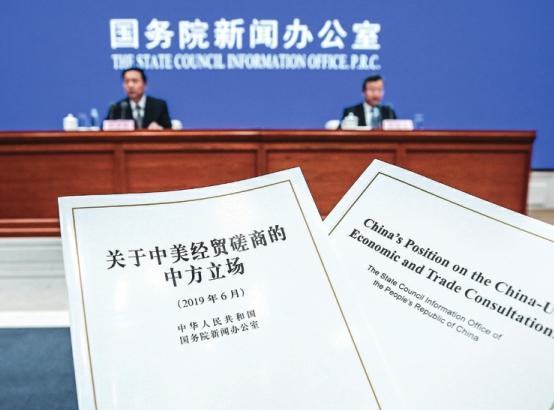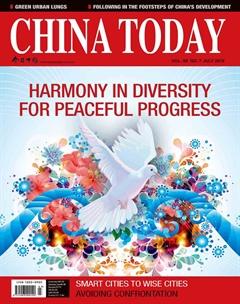Avoiding Confrontation
By AUGUSTO SOTO

ON May 20, 2019, as a result of Trumps threats, Google announced that it would not collaborate with Huawei. Many analysts have speculated that a discord similar to the Cold War, a division that those of us who had to experience it would not like to relive again might arise once more. For this time, if a comparable conflict were to be unleashed, it would immediately be reflected on much of the world. In the 1980s, at the height of the Cold War, trade between the United States and the Soviet Union reached US $2 billion annually; today, China-U.S. trade reaches that figure daily. According to the IMF, China accounts for 20 percent of global GDP and is the first trading partner of more than 120 countries. Chinas current message to the international community is that it is flexible to negotiate while at the same time defending its core interests.
An Explanation
In the absence of a partial or coherent explanation from the Trump administration, the Chinese government released on June 2 the white paper titled, Chinas Position on the China-US Economic and Trade Consultations. It details the damage caused by the trade frictions started by the U.S., its negotiating swings that have resulted in regression in the consultation process, and the Chinese availability to continue participating in reliable bilateral talks based on principles that Beijing considers impossible to bargain, such as equality and mutual benefit. During the presentation of the white paper, the Chinese Vice Minister of Commerce, Wang Shouwen, clarified that Beijing is convinced that the U.S. administration has manipulated data on trade deficit and intellectual property for the purpose of fuelling friction and imposing more tariffs on China, thus forcing Beijing to take measures to defend its core interests. In truth, Beijing emphasizes that Washington puts the interests of both countries and the rest of the world at risk, ignoring the search for a shared profit that would be more appropriate to the framework of economic and commercial cooperation traditional among countries. In June 2019, it is evident that the Trump administration has instigated an increase in protectionism, triggering a domino effect since the conflict is moving simultaneously to several countries without a foreseeable end. In other words, we are at an extremely dangerous juncture that has been described by the director general of the World Trade Organization (WTO), Roberto Azevedo, as the bleakest for world trade since 1947.
Historical Lessons
It is worth remembering that Washington has periodically singled out countries perceived as a threat to its hegemony. Once identified, it tries to retard the competitors development as much as possible, regardless of whether it is an ally or not. In the 1980s Washington feared the rise of the Japanese economy, which was approaching the size of the United States. Stephen S. Roach, an American economist with extensive experience in Washington and the private sector at the highest level (and a direct witness of the case), has recently recalled how Tokyo was then charged with similar terms as how Chinas behaviour is currently being defined. That is to say, of state-sponsored industrial policy, an outsize bilateral trade deficit, currency manipulation, and ultimately hollowing out U.S. manufacturing. Tokyo ceded to Washingtons demands, discontinuing its genuine development path, and then suffered nearly three decades of economic stagnation. Beyond this example, it can be added that Russias recent history offers – mutatis mutandis – a comparable case. Few years after the collapse of the Soviet Union, Washington sought to promote (in a Moscow with doors open then) a dysfunctional economic model for Russia, which in fact contributed to its greater decline and backwardness vis-à-vis the U.S. Thus, Beijing relies on its own experience and also on that of its neighbours in recent clashes with the worlds hegemon. In the abovementioned white paper published on June 2, Beijing notes that it has perceived that in bilateral negotiations “the more the U.S. government offers, the more it wants.”
Conflicts
Last April, in a public meeting, former U.S. president Jimmy Carter, who oversaw the normalization of his countrys diplomatic relations with Beijing in 1979, recalled that China has not been involved in any armed clashes, unlike the U.S., which, according to him, in this period has squandered about US $3 tril- lion in wars around the world. Carter highlighted that spending has been at the expense of developing the infrastructure required by his own country, while China has been investing its resources in domestic development. As a result, today China has the worlds largest high-speed rail network. Carter concluded his remarks by considering the Unites States “the most warlike nation in the history of mankind” because of its desire to impose American values on other countries. The most recent example of this hegemony acquiring grotesque proportions during the Trump administration is its desire to prevent Europe from having an autonomous defense industry based on its own suppliers.
It is a hegemonic drive reminiscent of last Aprils visit of the Secretary of State, Mike Pompeo, to South America, where he warned of the presence there of Huawei. In short, the foregoing, coupled with the Trump administrations most recent insistence on reinforcing the southern border wall and threating to imposing new tariffs on Mexico poses further risk of money and time wasting for Mexico, the U.S., and the world.
Greed and Well-being
Another reputed American economist, Jeffrey Sachs, advisor to the UN Secretary-General, has recently highlighted in a CNN online article the extension of corporate greed in his country. According to him, American capitalism has departed from the cooperative spirit, turning into an internal injustice which is inflaming Americas trade conflicts. And this is happening because business leaders and Americas great fortunes push for tax cuts, promote more monopolies and offshoring, and reject socially fairer policies. According to Sachs, “the real battle is not with China but with Americas own giant companies.”
From all of the above, it is concluded that if the United States uses its resources better, it would have a higher quality of life, worthy of its recent past. In the last 20 years, the USA shows (despite its technological vitality) an alarming stagnation of its life expectancy, whether we compare it to the OECD countries or to China. Indeed, Beijings life expectancy is now 82 years and Washingtons 77. Meanwhile, in the American hemisphere (also regarding life expectancy) the United States has been lagging behind four countries.
- CHINA TODAY的其它文章
- People-oriented Development Brings Boons to Both China and the World
- Xi Urges Joint Efforts to Open Up New Prospects for Asian Security,Development
- Commercialization of 5G Accelerates Digital Transformation
- Romania Holds 1st TCM International Conference
- Global Communication Shall Not Be Subject to U.S.‘Digital Hegemony’
- Huawei’s World View

